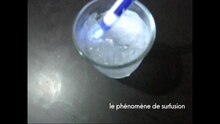Hypothermia (thermodynamics)
In thermodynamics, undercooling refers to an unstable state after a drop in temperature , if actually a phase transition due to cooling , e.g. B. solidification should take place, but which is inhibited. There are different types of subcooling, freeze delay, condensation delay and solid-solid delayed phase transition. Sometimes oversaturation , which is caused by cooling, is also counted as hypothermia.
The freeze delay cools liquid to below freezing point without it solidifying . In general, this effect is also known as supercooled melt . A supercooled liquid or melt thus has a lower temperature at a given pressure than corresponds to its physical state . Inoculating with the smallest germs , possibly also impulse transmission in the form of vibrations, leads to spontaneous crystallization with the release of the melting enthalpy . Therefore, hypothermia is called metastableCondition of the substance. This area is also called the Ostwald-Miers area .
A (mostly very pure) substance that allows the state of the supercooled melt, therefore, enables energy to be stored in the form of heat ( latent heat storage ). This effect is used in hand warmers , among other things .
root cause
The reason for this effect is that a crystallization approach is often necessary to change the physical state. For example, ice crystals only grow on ice crystals and some other arrangements. If these crystallization approaches are not present, crystallization and thus the change in the state of aggregation cannot occur, even if it were possible due to the temperature.
Historical
The discoverer of hypothermia is Israel Conradi (1634–1715), a doctor of medicine and well-known naturalist in Gdansk . In 1677 he reported a large number of experiments on cold, in which he also discovered hypothermia. Daniel Gabriel Fahrenheit described in 1724 that he could cool boiled water in still vessels about four degrees below freezing point without it solidifying. In the event of vibrations, however, there was sudden partial freezing, with the water penetrating with ice needles. Charles Blagden described his research on the freezing delay of water in 1788 and found that purer water tends to be more hypothermic. Joseph Louis Gay-Lussac cooled water, which was covered with a layer of oil, to −12 degrees without freezing.
Web links
- Explanation using the example of water
- Enhanced Grüneisen parameters in Supercooled Water
- Several videos of experiments on YouTube
Individual evidence
- ^ Gabriel O. Gomes, H. Eugene Stanley, Mariano de Souza: Enhanced Grüneisen Parameter in Supercooled Water . In: Scientific Reports . tape 9 , no. 1 , August 19, 2019, ISSN 2045-2322 , p. 1–8 , doi : 10.1038 / s41598-019-48353-4 ( nature.com [accessed January 4, 2020]).
- ↑ a b Ludwig Darmstaedter, René Du Bois-Reymond, Carl Schaefer (eds.): Ludwig Darmstaedter's handbook on the history of natural sciences and technology . In chronological representation. Julius Springer, Berlin 1908, chap. 1788 , p. 143 ( online in the Internet Archive [accessed on May 7, 2017]): "the hypothermia first observed by J. Conradi (see 1677 C.)"
- ↑ Ludwig Darmstaedter, René Du Bois-Reymond, Carl Schaefer (ed.): Ludwig Darmstaedter's handbook on the history of natural sciences and technology . In chronological representation. Julius Springer, Berlin 1908, chap. 1788 , p. 249 ( online in the Internet Archive [accessed on May 7, 2017]): "1677 Israel Conradi [...] first describes the hypothermia of water"
- ^ Hans-Jürgen Kämpfert: Conradi, Karl Friedrich Freiherr von. School donors. In: East German biography. Kulturportal West Ost, accessed on May 4, 2017 .
- ↑ Christian Freiherr von Wolff (ed.): All hand useful attempts . As a result, the way to more precise knowledge of nature and art is paved. tape 2 . Renger, Halle 1747, VIII On the heat and cold, p. 345 ( limited preview in the Google book search [accessed on May 4, 2017]): "A learned physician in Danzig Israel Conradi, who A. 1677 had a large number of experiments printed on the cold"
- ↑ Abraham Gotthelf Kästner (Ed.): Physical library . in which the most distinguished writings belonging to natural science are displayed, with many additions and improvements. Johann Wendlern, Leipzig 1754, 7. From the air. §12, p. 193 ( limited preview in the Google book search [accessed on May 4, 2017]): "Israel Conradi collected some of the nature and effects of the cold in 1677, in special dissertations."
- ^ Israel Conradi: Dissertation medico-physica de frigoris natura et effectibus . Monastery Oliva (monasterii Olivensis) 1677 (Latin, limited preview in Google Book Search [accessed on May 4, 2017] MDCLXXVII = 1677).
- ↑ a b Ernst Mach : The principles of heat theory . Historically and critically developed. Johann Ambrosius Barth, Leipzig 1896, Historical overview of the development of calorimetry, p. 163 ( online in the Internet Archive [accessed May 4, 2017]).
- ^ A b Daniel Gabriel Fahrenheit : Experimenta & Observationes De Congelatione Aquae in Vacuo . Factae a DG Fahrenheit, RSS In: Philosophical Transactions . tape 33 , no. 381-391 , 1724, ISSN 0261-0523 , p. 78–84 , doi : 10.1098 / rstl.1724.0016 (Latin, royalsocietypublishing.org [accessed May 7, 2017]).
- ^ Charles Blagden : Experiments on the cooling of water below its freezing point . Read January 31, 1788. In: Royal Society (Ed.): Philosophical Transactions of the Royal Society of London . tape 78 . London 1788, p. 125–146 , doi : 10.1098 / rstl.1788.0011 , JSTOR : 106652 (English, Blagden uses the Fahrenheit scale , i.e. the freezing point of water is 32 °): “the distilled water readily sunk many degrees below 32 °, still continuing fluid [...] the greatest cooling usually took place when the water was most clear ”
- ↑ Rudolf Plank : Thermodynamic Basics (= Handbuch der Kältetechnik . Volume 2 ). Springer-Verlag, Berlin Heidelberg 1953, ISBN 978-3-642-88487-0 , The thermal quantities in the wet steam area, p. 105 , doi : 10.1007 / 978-3-642-88486-3 ( limited preview in Google Book Search [accessed May 7, 2017]).
